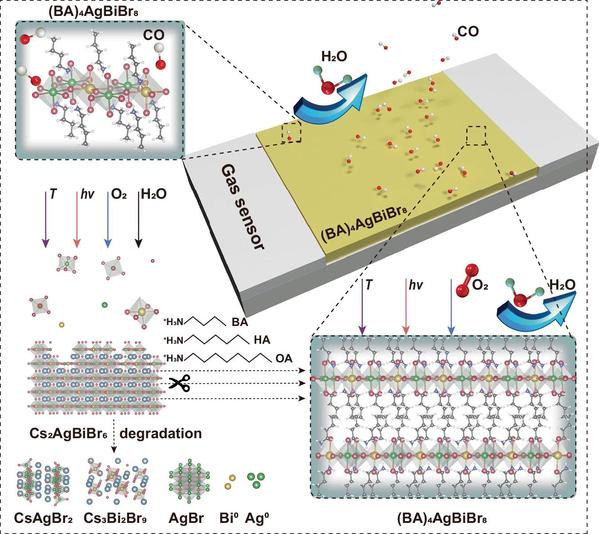Dimensional reduction in Cs2AgBiBr6 enables long-term stable Perovskite-based gas sensing
Wen Ye1,2, Hong-Zhen Lin3, Menglong Li1, Lihua Jiang1, Dongyun Chen1(陈冬赟)*, Jian-Mei Lu1(路建美)*
1State Key Laboratory of Bioinspired Interfacial Materials Science, College of Chemistry Chemical Engineering and Materials Science,Collaborative Innovation, Center of Suzhou Nano Science and Technology, National United Engineering Laboratory of Functionalized Environmental Adsorption Materials, Soochow University, Suzhou, China.
2Key Laboratory of Intelligent Optoelectronic Devices and Chips of Jiangsu Higher Education Institutions, School of Physical Science and Technology, Suzhou University of Science and Technology, Suzhou215009, China.
3Departmenti-LAB, Suzhou Institute of Nano-Tech and Nano Bionics (SINANO), Chinese Academy of Sciences, Suzhou, China.
Nat. Commun.,2025, 16, 4820.
Abstract: Halide perovskite gas sensors have a low gas detection limit at room temperature, surpassing the performance of traditional metal oxide chemiresistors. However, they are prone to structural decomposition and performance loss due to the lack of coordination unsaturated surface metal ions and sensitivity to environmental factors such as water, oxygen, heat, and light. To address this issue, we present a general strategy: replacing the cation Cs+ in inorganic perovskite Cs2AgBiBr6 with long-chain alkylamines. This modification synthesizes perovskite sensor materials that effectively block moisture and exhibit excellent stability under real-working conditions. The chemiresistors show high sensitivity and stability to CO gas, with (BA)4AgBiBr8 detecting CO at a limit of 20 ppb, maintaining performance after 270 days of continuous exposure to ambient air. The exceptional performance of (BA)4AgBiBr8 is elucidated through density functional theory calculations combined with sum frequency generation spectroscopy, marking a significant breakthrough in halide perovskite-based gas sensing by surpassing the stability and sensitivity of traditional sensors.

Article information: //doi.org/10.1038/s41467-025-60206-5